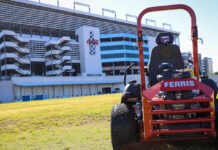By Missy Henriksen
From the October 2017 Issue
Sustainability is more popular than ever across the board, and forward-thinking environmental practices can no longer be ignored. As a result, many facility management executives continue to move toward sustainable landscapes as a part of an overall commitment to social responsibility in their organizations. Beyond that aim, many are also finding that their sustainable landscapes promote the long-term health of grass, trees, shrubs, and flowers; save money on landscape investments in the long-term; require less maintenance; and improve curb appeal. It seems the grass is in fact “greener” on the other side.

Sustainable landscapes—which can be defined as those that are balanced with local climates and require minimal resource inputs, such as water, energy, and nutrients—are now seen as a necessity in ensuring a commercial property’s success. For those not sure how to take the first step toward sustainability, here are five best practices to keep in mind when going green.
1. Identify small changes that will make a big impact. If the idea of creating a sustainable landscape seems overwhelming, keep in mind that there are many low-cost, high-impact projects that do not require a major overhaul of existing plants and trees.
For example, facility managers can substantially lessen the environmental impact of their landscapes by working with a landscape professional to manage water use. A professional will begin by taking stock of any existing irrigation systems on the property. They might also recommend implementing regular irrigation system inspections, using efficient irrigation heads, and transitioning to smart controllers, which automatically adjust irrigation system run times based on local weather conditions. Irrigation system flow sensors, which can detect leaks, can also be added to help track water use, and reduce waste, liability, and costs.

In addition to water conservation practices enabled by smart technology for irrigation, natural stormwater volume can be harnessed through strategic design. A landscape professional can help with the design and implementation of bioswales and rain gardens—shallow trenches filled with vegetation—that are considered effective alternatives for retaining water runoff and reintroducing it back into the soil.
Both bioswales and rain gardens can be installed with a property’s existing native plants that require little to no maintenance—a win-win for facility managers and the surrounding environment.
2. Nurture existing plants and trees. While some believe that it’s best to start sustainability efforts with a clean slate, by removing all existing plants, most landscape professionals will advise that a landscape’s natural process not be disrupted. If existing plants aren’t doing well in their current environment after regular maintenance and pruning, a professional might recommend these be moved to a new area to see if they thrive, before removing them from the property entirely.
Large, well-established trees should be properly maintained and pruned throughout each season to ensure their long-term health, as well as the safety of the facility’s regular occupants and guests. After all, trees not only add a great deal of aesthetic value to a commercial property but also promote sustainability by providing oxygen and sequestering carbon dioxide.
3. Plant with a purpose. While all plants—whether they are trees, shrubs, flowers, or grasses—benefit the environment through their release of oxygen, it is important to choose plants wisely when working toward a sustainable landscape on commercial properties.

The best way to conserve water and reduce a landscape’s carbon footprint is to select native or drought tolerant plants, and landscape professionals can assist. Most native or drought tolerant plants easily adapt to their region’s specific climate, requiring little irrigation beyond natural rainfall once they are established. Slowly introducing diversity to a landscape by layering plant material is also a smart and sustainable strategy that attracts wildlife and beneficial insects, optimizes carbon sequestration, and promotes a more complex and healthier ecosystem overall.
4. Look for opportunities to recycle landscape “waste.” Although large commercial properties can produce a lot of landscape waste, the good news is much of this discarded material—like grass clippings, unused dirt, fallen leaves, and fallen tree limbs—can actually be reused instead of thrown away.
One way to reuse landscape waste is through composting, which is a microbial process that converts plant materials like grass clippings and leaves to organic soil. Not only does composting cut down on waste, but it returns important nutrients to the ground that help plants thrive.
Another method of composting is “grasscycling,” where grass clippings are left on the lawn after it is mowed to act as a natural fertilizer. An additional eco-friendly way to repurpose landscape waste is to turn a property’s leaves, grass clippings, and branches into mulch for use in garden beds. Not only is fresh mulch attractive, but it also insulates tree and shrub roots, providing protection from the elements during colder months, and helps to retain much needed moisture in the soil so that plants require less watering.
When implementing a sustainability program, facility managers should discuss these options and other ways to recycle their property’s organic waste with their landscape contractor.
5. Don’t limit your landscape. If a commercial property is limited in outdoor space or located in an urban setting, think outside the box when increasing the landscape’s sustainability. Green roofs and walls—vegetative layers lining a building’s roof or walls—provide many benefits, including the production of oxygen, cooling, and insulation for the building that results in energy savings, a reduction of stormwater runoff, and a stress reducing green space for occupants to enjoy. Professionals can assist facility managers and executives with the design and implementation of a sustainable green roof or vertical wall garden. Options can range from simply adding a few inches of plant covering to developing a complete park-like setting with plants, trees, and recreational space.
When thinking about opportunities to enhance a property’s eco-friendly features, keep in mind all the options and benefits that come with investing in a sustainable landscape. Not only are these good for the environment, but sustainable landscapes often require less maintenance and even serve as a selling point for tenants and other types of occupants. Ready to go green? Landscape professionals can help design and implement eco-friendly landscapes that protect and improve commercial properties’ environments.
 Henriksen is vice president of public affairs for the National Association of Landscape Professionals, which represents an industry that employs nearly one million landscape, lawn care, irrigation, and tree care professionals who create and maintain healthy green spaces for the benefit of society and the environment.
Henriksen is vice president of public affairs for the National Association of Landscape Professionals, which represents an industry that employs nearly one million landscape, lawn care, irrigation, and tree care professionals who create and maintain healthy green spaces for the benefit of society and the environment.
Do you have a comment? Share your thoughts in the Comments section below or send an e-mail to the Editor at acosgrove@groupc.com.











![[VIDEO] Dickies®: Discover Workwear That’s Anything But Uniform](https://turfmagazine.com/wp-content/uploads/2023/06/1647663814-4b1a2a7742790a9b1e97a3b963477850192e1d6a9dfba9b07214a77bae25d6e3-d-218x150.jpg)






























![[VIDEO] Dickies®: Discover Workwear That’s Anything But Uniform](https://turfmagazine.com/wp-content/uploads/2023/06/1647663814-4b1a2a7742790a9b1e97a3b963477850192e1d6a9dfba9b07214a77bae25d6e3-d-324x160.jpg)